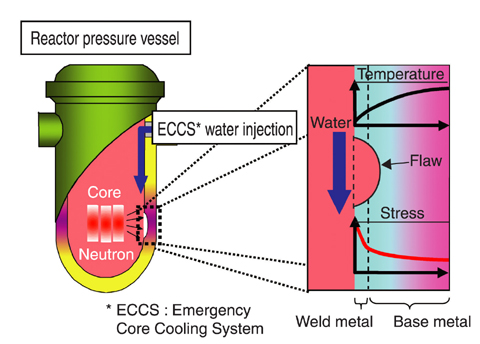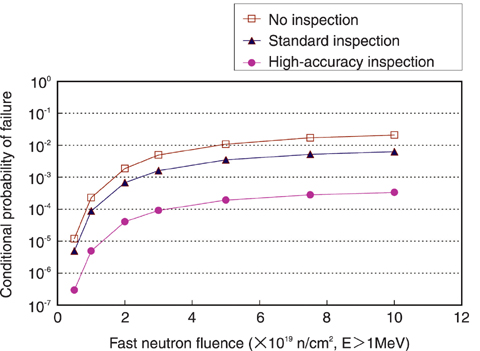
Fig.5-11 The concept of PTS

Fig.5-12 The conditional probability of failure of an RPV as a function of fast neutron fluence computed with PASCAL
Some of the light water reactors (LWRs) in Japan have been operated for over 30 years. To assure the structural integrity of components is an important issue for the safe operation of these aged LWRs. Probabilistic Fracture Mechanics (PFM) has attracted a great deal of interest as a useful tool for evaluating the failure probability of aged components appropriately. In the PFM approach, the uncertainties of loads applied to structural components, the distributions of flaw size, and the probability of occurrence of flaws are considered.
We have developed a PFM analysis code PASCAL. This code evaluates the conditional probabilities of failure of a reactor pressure vessel (RPV) under transient loading conditions such as pressurized thermal shock (PTS), the concept of which is shown in Fig.5-11. The following is a brief description of the analysis function of PASCAL.
RPV steel is subjected to neutron irradiation from the reactor core, so that it tends to embrittle as operation continues. This phenomenon is evaluated using the embrittlement prediction equation formulated in Japan. For the assessment of structural integrity of the RPV, a flaw in the RPV wall is assumed to exist. The flaw size is chosen from among a distribution of flaw sizes using a random number (i.e. flaw sampling). The flaw is evaluated as to its growth and whether it penetrates the RPV wall during a PTS. The sampling is repeated, and the conditional probability of failure is calculated as the ratio of the number of failed flaws to the number of samples. In PASCAL, one can analyze easily by setting various parameters on graphical user interface (GUI) including the type of a transient, the chemical compositions in steel, and the accuracy of nondestructive inspection.
The effect of nondestructive inspection on the conditional probability of failure is shown in Fig.5-12. Any nondestructive inspection reduces the failure probability. Especially, the failure probability after an inspection with high accuracy was reduced to approximately 1/100 that where there was no inspection.
We are continuing research to incorporate the latest knowledge about evaluation items such as residual stress distributions in PASCAL, focusing on making a contribution to possible revisions of codes and standards.
This work was performed by JAEA under the contract research entrusted from the Ministry of Economy, Trading and Industry of Japan.